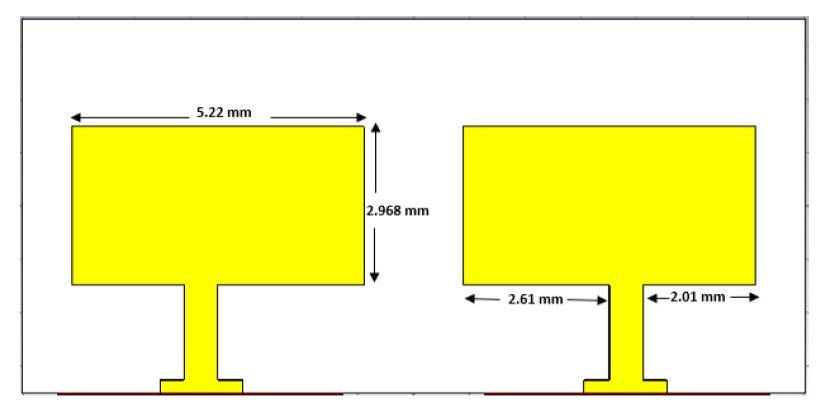Mutual Coupling Reduction in 5G Multiple Input Multiple Output Microstrip Patch Antenna
Keywords:
5G communication, T-shaped gap, Mobile device integration, Urban communication systems, Gain enhancementAbstract
This study delineates the design and performance assessment of a small 28 GHz single-band Multiple-Input Multiple-Output (MIMO) antenna designed for fifth-generation (5G) wireless communication systems. The proposed antenna employs T-shaped gaps among radiating elements to mitigate mutual coupling, a critical issue in compact MIMO systems. Simulation results demonstrate a significant increase in isolation, with the Return Loss (RL) improved from −17 dB to −46 dB. Furthermore, the overall radiation efficiency increases from 71.5% to 76.8%, indicating an improvement in system performance. The design incorporates polarisation variety to alleviate multipath fading, a common challenge at millimeter-wave frequencies. The proposed antenna, characterized by its exceptional isolation, improved gain, and compact design, is well suited for integration into modern mobile devices and 5G-enabled platforms, including Internet of Things (IoT) networks, autonomous systems, and densely populated urban communication environments.
References
L. J. Vora, “Evolution of mobile generation technology: 1G to 5G and review of upcoming wireless technology 5G,” Int. J. Mod. Trends Eng. Res, vol. 2, no. 10, pp. 281–290, 2015.
M. Attaran, “The impact of 5G on the evolution of intelligent automation and industry digitization,” J. Ambient Intell. Humaniz. Comput., vol. 14, no. 5, pp. 5977–5993, May 2023, doi: 10.1007/S12652-020-02521-X/METRICS.
H. I. Visser, “Multiband microstrip slot antenna with multiple-input and multiple-output (MIMO) implementation for handheld devices,” Ph.D. Diss. San Diego State Univ, 2013.
U. Uddin, W. Akaram, and M. R. Anasri, “Design and Analysis of Microstrip Patch Antenna and Antenna Array for Vehicular Communication System,” Proc. Int. Conf. Inven. Commun. Comput. Technol. ICICCT 2018, pp. 1746–1751, Sep. 2018, doi: 10.1109/ICICCT.2018.8473134.
M. I. Ahmed, A. Sebak, E. A. Abdallah, and H. Elhennawy, “Mutual coupling reduction using defected ground structure (DGS) for array applications,” 2012 15th Int. Symp. Antenna Technol. Appl. Electromagn. ANTEM 2012, 2012, doi: 10.1109/ANTEM.2012.6262354.
abdelati REHA, “Microstrip Patch Antenna Array and its Applications: a Survey,” Jan. 2020, doi: 10.9790/1676-1501012638.
C. A. Balanis, “Antenna Theory: Analysis and Design,” John Wiley Sons, Inc., Hoboken, New Jersey, 2015, [Online]. Available: https://ia800501.us.archive.org/30/items/AntennaTheoryAnalysisAndDesign3rdEd/Antenna Theory Analysis and Design 3rd ed.pdf
C. A. Balanis, “Fundamental Parameters and Definitions for Antennas,” Mod. Antenna Handb., pp. 1–56, Nov. 2007, doi: 10.1002/9780470294154.CH1.
R. Rodrigo, “Fundamental parameters of antennas”, [Online]. Available: http://pongsak.ee.engr.tu.ac.th/le428/chap2.pdf
M. S. . Sharawi, “Printed mimo antenna engineering,” p. 295, 2014.
Y. W. Qian Li, Chong Ding, Ruichao Yang, Mingtao Tan, Gangxiong Wu, Xia Lei, Xuebing Jiang, Shuanzhu Fang, Minzhi Huang, Yubin Gong, “Mutual Coupling Reduction between Patch Antennas Using Meander Line,” Int. J. Antennas Propag., 2018, doi: https://doi.org/10.1155/2018/2586382.
K. Bangash, M. M. Ali, H. Maab, and H. Ahmed, “Design of a Millimeter Wave Microstrip Patch Antenna and Its Array for 5G Applications,” 1st Int. Conf. Electr. Commun. Comput. Eng. ICECCE 2019, Jul. 2019, doi: 10.1109/ICECCE47252.2019.8940807.
M. El Shorbagy, R. M. Shubair, M. I. Alhajri, and N. K. Mallat, “On the design of millimetre-wave antennas for 5G,” Mediterr. Microw. Symp., vol. 0, Jul. 2016, doi: 10.1109/MMS.2016.7803878.
T. S. Rappaport et al, “Millimeter Wave Mobile Communications for 5G Cellular: It Will Work!,” IEEE Access, vol. 1, pp. 335–349, 2013, doi: 10.1109/ACCESS.2013.2260813.
D. Imran et al., “Millimeter wave microstrip patch antenna for 5G mobile communication,” 2018 Int. Conf. Eng. Emerg. Technol. ICEET 2018, vol. 2018-January, pp. 1–6, Apr. 2018, doi: 10.1109/ICEET1.2018.8338623.
N. Kaur and S. Malhotra, “A review on significance of design parameters of microstrip patch antennas,” 2016 5th Int. Conf. Wirel. Networks Embed. Syst. WECON 2016, Jul. 2017, doi: 10.1109/WECON.2016.7993491.
A. Mukhopadhyay et al., “Bandwidth enhancement of a microstrip patch antenna using Cuckoo Search optimization,” 2017 1st Int. Conf. Electron. Mater. Eng. Nano-Technology, IEMENTech 2017, Oct. 2017, doi: 10.1109/IEMENTECH.2017.8076930.
H. Arun, A. K. Sarma, M. Kanagasabai, S. Velan, C. Raviteja, and M. G. N. Alsath, “Deployment of modified serpentine structure for mutual coupling reduction in MIMO antennas,” IEEE Antennas Wirel. Propag. Lett., vol. 13, pp. 277–280, 2014, doi: 10.1109/LAWP.2014.2304541.
C. Oestges, M. Guillaud, and M. Debbah, “Multi-polarized MIMO communications: Channel model, mutual information and array optimization,” IEEE Wirel. Commun. Netw. Conf. WCNC, pp. 1058–1062, 2007, doi: 10.1109/WCNC.2007.200.
M. Sánchez-Fernández, E. Rajo-Iglesias, Ó. Quevedo-Teruel, and M. L. Pablo-González, “Spectral efficiency in MIMO systems using space and pattern diversities under compactness constraints,” IEEE Trans. Veh. Technol., vol. 57, no. 3, pp. 1637–1645, May 2008, doi: 10.1109/TVT.2007.909279.
X. Wang, Z. Feng, and K. M. Luk, “Pattern and polarization diversity antenna with high isolation for portable wireless devices,” IEEE Antennas Wirel. Propag. Lett., vol. 8, pp. 209–211, 2009, doi: 10.1109/LAWP.2008.2004511.
H. C. Huang, “Overview of antenna designs and considerations in 5G cellular phones,” 2018 IEEE Int. Work. Antenna Technol. iWAT2018 - Proc., pp. 1–4, Jun. 2018, doi: 10.1109/IWAT.2018.8379253.
Z. Ying, “Antennas in cellular phones for mobile communications,” Proc. IEEE, vol. 100, no. 7, pp. 2286–2296, 2012, doi: 10.1109/JPROC.2012.2186214.
K. H. Chen and J. F. Kiang, “Effect of mutual coupling on the channel capacity of MIMO systems,” IEEE Trans. Veh. Technol., vol. 65, no. 1, pp. 398–403, Jan. 2016, doi: 10.1109/TVT.2015.2397033.
A. Z. Xiaoming Chen, Shuai Zhang, “On MIMO-UFMC in the Presence of Phase Noise and Antenna Mutual Coupling,” Radio Sci., 2017, doi: https://doi.org/10.1002/2017RS006258.
A. S. D. Chins Chinnasamy, Yaaqoub Malallah, Melania M. Jasinski, “Synthesis of high magnetic moment soft magnetic nanocomposite powders for RF filters and antennas,” Appl. Surf. Sci., vol. 334, pp. 58–61, 2015, [Online]. Available: https://www.sciencedirect.com/science/article/abs/pii/S0169433214017590?via%3Dihub
C. Chinnasamy, J. Herr, R. Pai, B. Cui, W. Li, and J. F. Liu, “Gram scale synthesis of high magnetic moment Fe 100-xCo x alloy nanoparticles: Reaction mechanism, structural and magnetic properties and its application on nanocomposite,” J. Appl. Phys., vol. 111, no. 7, Apr. 2012, doi: 10.1063/1.3679438/370832.
N. Kuwabara and Y. Hiroshima, “Development of coupling and decoupling networks below 150 KHz,” IEEE Int. Symp. Electromagn. Compat., pp. 17–20, 1997, doi: 10.1109/ELMAGC.1997.617044.
S. K. Mukesh Kumar Khandelwal, Binod Kumar Kanaujia, “Defected Ground Structure: Fundamentals, Analysis, and Applications in Modern Wireless Trends,” Int. J. Antennas Propag., 2017, doi: https://doi.org/10.1155/2017/2018527.
A. K. Arya, M. V. Kartikeyan, and A. Patnaik, “Defected ground structure in the perspective of microstrip antennas: A review,” Frequenz, vol. 64, no. 5–6, pp. 79–84, Jun. 2010, doi: 10.1515/FREQ.2010.64.5-6.79/PDF/FIRSTPAGE.
Pravin Ratilal Prajapati, “Application of Defected Ground Structure to Suppress Out-of-Band Harmonics for WLAN Microstrip Antenna,” Int. J. Microw. Sci. Technol., 2015, doi: https://doi.org/10.1155/2015/210608.
K. Wei et al, “S‐shaped periodic defected ground structures to reduce microstrip antenna array mutual coupling,” Electron. Lett, vol. 52, no. 15, pp. 1288–1290, 2016, [Online]. Available: https://ietresearch.onlinelibrary.wiley.com/doi/epdf/10.1049/el.2016.0667
K. Wei, J. Y. Li, L. Wang, Z. J. Xing, and R. Xu, “Mutual Coupling Reduction by Novel Fractal Defected Ground Structure Bandgap Filter,” IEEE Trans. Antennas Propag., vol. 64, no. 10, pp. 4328–4335, Oct. 2016, doi: 10.1109/TAP.2016.2591058.
V. R. N. Chandrasekhar Rao Jetti, “Trident-shape strip loaded dual band-notched UWB MIMO antenna for portable device applications,” AEU - Int. J. Electron. Commun., vol. 83, pp. 11–21, 2018, [Online]. Available: https://www.sciencedirect.com/science/article/abs/pii/S1434841117302522?via%3Dihub
I. Nadeem and D. -Y. Choi, “Study on Mutual Coupling Reduction Technique for MIMO Antennas,” IEEE Access, vol. 7, pp. 563–586, 2019, [Online]. Available: https://ieeexplore.ieee.org/document/8567899
S. Alkaraki and Y. Gao, “2 × 2 and 4 × 4 MIMO antennas for 5G mm-wave wireless communication,” 2019 IEEE Int. Symp. Antennas Propag. Usn. Radio Sci. Meet. APSURSI 2019 - Proc., pp. 1419–1420, Jul. 2019, doi: 10.1109/APUSNCURSINRSM.2019.8889114.
R. N. Anzar Khan, “Analysis of Five Different Dielectric Substrates on Microstrip Patch Antenna,” Int. J. Comput. Appl., vol. 55, no. 14, 2012, [Online]. Available: https://research.ijcaonline.org/volume55/number14/pxc3882905.pdf
Elizabeth Lloyd, “Detection and Mitigation of GNSS Interference for Robust Navigation and Timing,” Ph.D. Diss. Univ. Bath, 2020, [Online]. Available: https://researchportal.bath.ac.uk/en/studentTheses/detection-and-mitigation-of-gnss-interference-for-robust-navigati
S. VEISEE, M. K. HEDAYATI, and S. ASADI, “A novel compact defected ground structure and its application in mutual coupling reduction of a microstrip antenna,” Turkish J. Electr. Eng. Comput. Sci., vol. 24, no. 5, 2016, [Online]. Available: https://journals.tubitak.gov.tr/elektrik/vol24/iss5/26/

Downloads
Published
How to Cite
Issue
Section
License
Copyright (c) 2025 50sea

This work is licensed under a Creative Commons Attribution 4.0 International License.




















